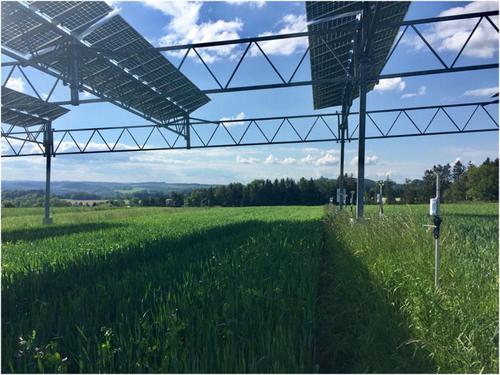Agronomy for Sustainable Development ( IF 7.3 ) Pub Date : 2022-06-01 , DOI: 10.1007/s13593-022-00783-7 Moritz Laub, Lisa Pataczek, Arndt Feuerbacher, Sabine Zikeli, Petra Högy

|
Despite the large body of research surrounding crop growth parameters, there is still a lack of systematic assessments on how harvestable yields of different crop types respond to varying levels of shading. However, with the advent of agrivoltaic systems, a technology that combines energy and food production, shade tolerance of cropping systems is becoming increasingly important. To address this research gap, a meta-analysis with data from two experimental approaches (intercropping and artificial shading with cloths, nets or solar panels) was performed. The aim was to quantitatively assess the susceptibility of different temperate crop types to increasing levels of shading. Crop type specific yield response curves were developed as a function of reduction in solar radiation, estimating relative crop yields compared to the unshaded controls. Only studies that reported reduction in solar radiation and crop yield per area in temperate and subtropical areas were included. The results suggested a nonlinear relationship between achieved crop yields and reduction in solar radiation for all crop types. Most crops tolerate reduced solar radiation up to 15%, showing a less than proportional yield decline. However, significant differences between the response curves of the following crop types existed: Berries, fruits and fruity vegetables benefited from reduction in solar radiation up to 30%. Forages, leafy vegetables, tubers/root crops, and C3 cereals initially showed less than proportional crop yield loss. In contrast, maize and grain legumes experienced strong crop yield losses even at low shade levels. The results provide a set of initial indicators that may be used in assessing the suitability of crop types for shade systems, and thus for agrivoltaic or other dual land-use systems. Detailed yield response curves, as provided by this study, are valuable tools in optimizing the output of annual crop components in these systems.
中文翻译:

对比不同阴影水平的产量反应表明作物对双重土地利用系统的不同适用性:荟萃分析
尽管围绕作物生长参数进行了大量研究,但仍然缺乏关于不同作物类型的可收获产量如何响应不同程度的遮荫的系统评估。然而,随着农业光伏系统(一种将能源和粮食生产相结合的技术)的出现,种植系统的耐荫性变得越来越重要。为了解决这一研究空白,对来自两种实验方法(间作和用布、网或太阳能电池板的人工遮光)的数据进行了荟萃分析。目的是定量评估不同温带作物类型对增加遮荫程度的敏感性。作物类型特定产量响应曲线被开发为太阳辐射减少的函数,与无阴影对照相比估计相对作物产量。仅包括报告在温带和亚热带地区单位面积的太阳辐射和作物产量减少的研究。结果表明,所有作物类型的作物产量与太阳辐射减少之间存在非线性关系。大多数作物耐受高达 15% 的太阳辐射减少,显示出低于比例的产量下降。然而,以下作物类型的响应曲线之间存在显着差异: 浆果、水果和水果蔬菜受益于高达 30% 的太阳辐射减少。牧草、叶类蔬菜、块茎/块根作物和 C 大多数作物耐受高达 15% 的太阳辐射减少,显示出低于比例的产量下降。然而,以下作物类型的响应曲线之间存在显着差异: 浆果、水果和水果蔬菜受益于高达 30% 的太阳辐射减少。牧草、叶类蔬菜、块茎/块根作物和 C 大多数作物耐受高达 15% 的太阳辐射减少,显示出低于比例的产量下降。然而,以下作物类型的响应曲线之间存在显着差异: 浆果、水果和水果蔬菜受益于高达 30% 的太阳辐射减少。牧草、叶类蔬菜、块茎/块根作物和 C3种谷物最初表现出小于成比例的作物产量损失。相比之下,即使在低遮荫水平下,玉米和谷物豆类也会遭受严重的作物减产。结果提供了一组初步指标,可用于评估作物类型对遮荫系统的适用性,从而评估农业或其他双重土地利用系统。本研究提供的详细产量响应曲线是优化这些系统中一年生作物成分产量的宝贵工具。


























 京公网安备 11010802027423号
京公网安备 11010802027423号